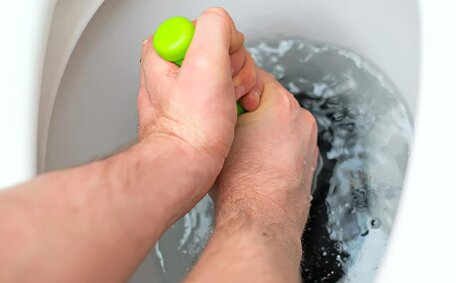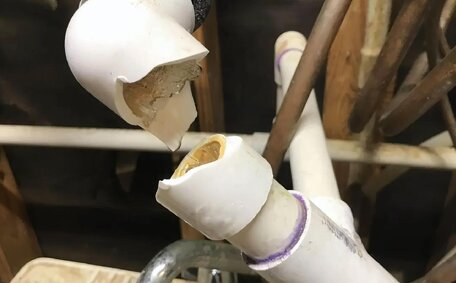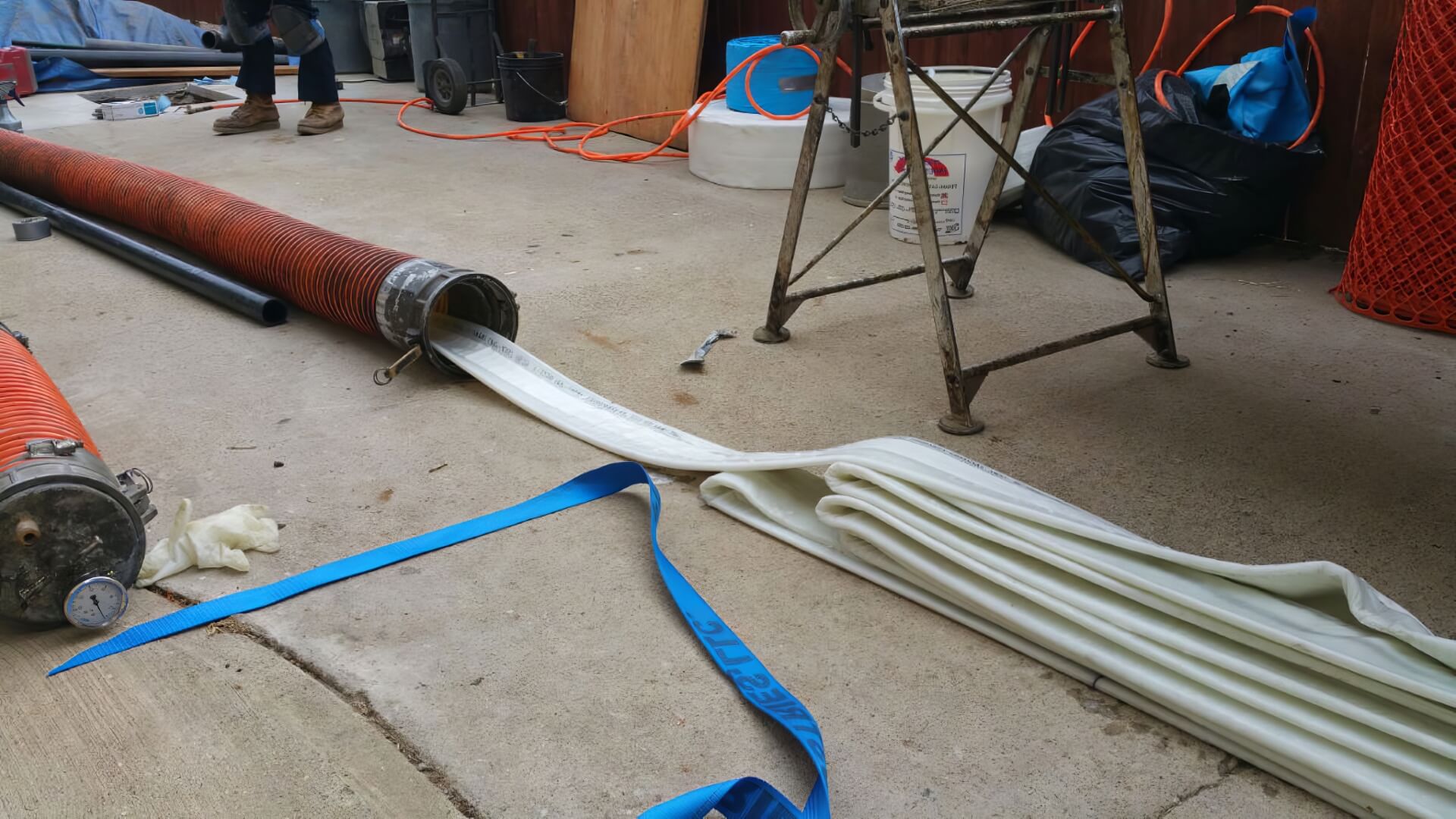Understanding pipe relining and the relining process
Pipe relining enhances your plumbing by providing a cost-effective method to restore damaged pipes, employing a new lining within the existing framework. This technique forgoes excavation, as it inserts and cures new lining within the current pipes.
Pipe relining offers significant advantages over traditional pipe replacement, being less invasive with minimal disruption to your property, and it eliminates the need for extensive excavation.
Technicians commence the process with a CCTV inspection to locate any cracks, breaks, or intrusions by tree roots.
Next, we use specialised equipment to clear debris with compressed air, preparing for the insertion of the cured-in-place pipe (CIPP) lining. The liner, made of epoxy resin capable of repairing various pipe types, is saturated under heat and pressure before it is placed inside the existing pipe for revitalisation. Owing to its durability, the liner seamlessly forms a new pipe inside, fitting securely within the existing one. Relining specialists use hot water or UV light to cure the liner, creating a robust new pipe within the old one.
The cured pipe lining provides durability and resistance, making it an ideal repair solution for damaged and blocked pipes, effectively extending the plumbing system’s lifespan.
Pipe relining is a long-lasting solution to effectively rectify cracked and badly corroded pipes. Choosing pipe relining provides a substantial solution that avoids digging up your garden and fully replacing pipes—a convenient option that often prompts consideration of its cost compared to traditional methods.
Why routine cleaning of relined pipes is important
Routine cleaning and maintenance of all pipe types, particularly using high-pressure techniques, ensure the ongoing functionality and longevity of your plumbing system. Here’s insight into how pipe relining work unfolds and what you should understand - Relined pipes require regular cleaning to prevent issues like tree root intrusion, an important aspect of pipe relining upkeep.
Even relined pipes can accumulate residue, grime, and mineral deposits over time.
If left unchecked, this buildup narrows the inside diameter of pipes, eventually leading to reduced water flow, backups, and potential blockages. Over time, tiny cracks may develop in the relined coating, becoming weak points for leaks, corrosion, and tree root intrusion, potentially leading to blockages.
We recommend sewer pipe relining and biennial inspections with CCTV drain cameras to maintain pipe health. Technicians will meticulously clean the pipes, ensuring seamless repairs and early detection of any new concerns. Our pipe repair methods allows us to expertly remove any contaminants sticking to the inside of pipes without causing damage to the relining surface.
Regular pipe inspections and preventative cleaning underscore the durability of pipe relining, maintaining smooth, debris-free pipes for over 50 years. Regular maintenance helps prevent leaks, prolongs service life, minimises backups, and mitigates deterioration, securing a pure water supply and circumventing expensive excavation for buried pipe repairs.
Effective cleaning agents and tools
When cleaning relined pipes, it’s crucial to use non-abrasive agents and tools that will not damage the protective epoxy coating inside. Use half a cup of white vinegar to break down deposits, followed by a hot water flush after 15 minutes.
We recommend starting with baking soda - sprinkle a cup down sinks and drains, followed by a pot of hot water to dissolve residue.
Employ plastic drain snakes, gentler plumbers’ brushes, and malleable hoses for manual interior scrubbing. Consider hydro-jetting for intensive maintenance, utilising high-pressure hot water steam to thoroughly clean pipes without damaging the inner surface. Employ plastic drain snakes, gentler plumbers’ brushes, and malleable hoses for manual interior scrubbing.
Avoid metal wire brushes or harsh chemical drain cleaners as these can scratch or corrode the relined surface over time.
Overall, take care to use only non-abrasive, pH-neutral agents with soft, plastic pipe tools when cleaning relined pipes. Manual scrubbing combined with hot pressurised water rinsing is ideal to keep pipes debris-free without damaging the epoxy lining inside - ensuring decades more service life.
Step-by-step process for cleaning relined pipes
Follow this step-by-step process to properly clean your relined pipes without causing any damage:
- Inspect pipes using a drain camera - A technician will utilise the CCTV drain camera in the relining pipe process to identify any residual buildup or new issues.
- Prepare cleaning agents and tools - Gather non-abrasive products like baking soda, vinegar and soft plastic brushes/hoses to use.
- Apply cleaning solutions - Sprinkle baking soda then pour vinegar into the pipes. Let sit for 15 minutes.
- Rinse thoroughly - Flush the pipes with very hot, pressurised water to dissolve and dislodge debris.
- Manually scrub inside pipe - A supple brush or drain snake can be used to tenderly stir and scour the sides pipe to detach any clinging residue.
- Final hot water rinse - Flush pipes for a final time with hot, pressurised water to wash away all loosened contaminants.
- Inspect pipes again - Technicians will examine the pipes once more using a drain camera to ensure they are clean.
Following this safe process using non-abrasive solutions and calibrated jet sprayers protects the epoxy lining from damage during cleaning. Routine maintenance ensures your relined pipes can last clog-free for decades and the pipe relining remains functional.
Tips to prevent future buildup
Here are some essential tips to help prevent buildup recurrence inside relined pipes:
- Dispose of fats, oils and food scraps properly - Avoid pouring grease down drains to prevent solidification and interior coating, thus maintaining the quality of your relined pipes. Scrape plates and dispose into bins before washing.
- Conduct weekly hot water flushes - Run hot taps for 5 minutes to dissolve deposits and cleanse the pipe interiors.
- Opt for pH-neutral cleaners - Vigorous acid or alkali-based solutions could impair various types of pipe materials and epoxy linings over repeated applications.
- Install basket strainers - Basket strainers in sink drains catch food scraps and debris before entering pipes.
- Consider pipe gaskets - Leaky pipe joints allow mineral deposits to quickly accumulate. Have a plumber inspect pipes and install new gaskets.
- Routine professional maintenance - Have pipes inspected every year or two by technicians to perform thorough hydro-jetting maintenance.
Persistent cleaning habits, avoiding abrasive chemicals, and promptly addressing any joint issues or cracks can prevent recurring buildup, ensuring relined pipes remain functional.
Knowing when to call a professional plumber
There are a few key signs indicating you need to call in a professional pipe relining specialist to inspect or clean your relined pipes:
- Recurring drain clogs or slow draining water
- Gurgling sounds coming from pipes
- Low water pressure
- Leaky pipe joints causing damp patches on walls/ceilings
- Noticing a musty odour from drains
- Noticing collapsed or sunken sections along the pipe route
Constant blockages, leaks, or flow concerns indicate accumulation inside pipes, reducing diameter and hindering water flow. Or sections of pipe may have suffered damage despite the relining, corroding or cracking yet again.
Don’t hesitate to engage with our team for comprehensive pipe relining service the moment any of these issues are noticed. Early identification of pipe issues enables our experienced team to accurately address them using CCTV drain cameras and advanced scanning tools.
Our experts have the necessary knowledge and expertise to safely clean drains and restore compromised sections without harming the integrity of the epoxy liners. Our prompt call-out services, pipeline solutions, and maintenance tasks ensure your relined plumbing remains optimally efficient.
For inspection, cleaning or repairs of your relined pipes, reach out to Castle Hill Plumbing at 1300 349 338 or email us at jobs@plumberscastlehill.com.au.






